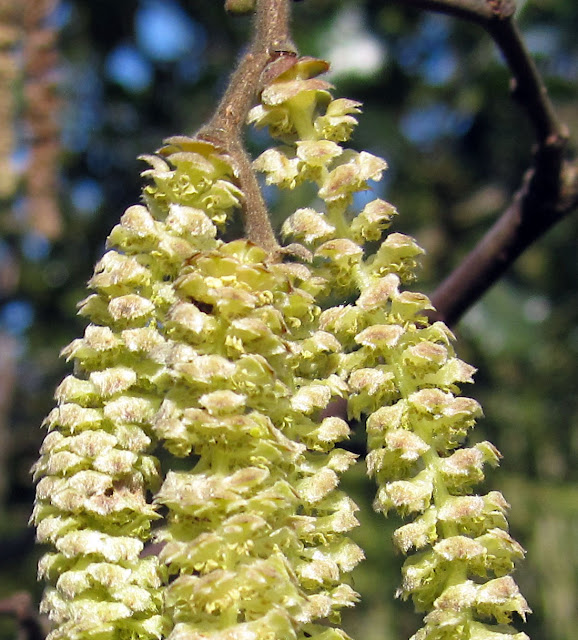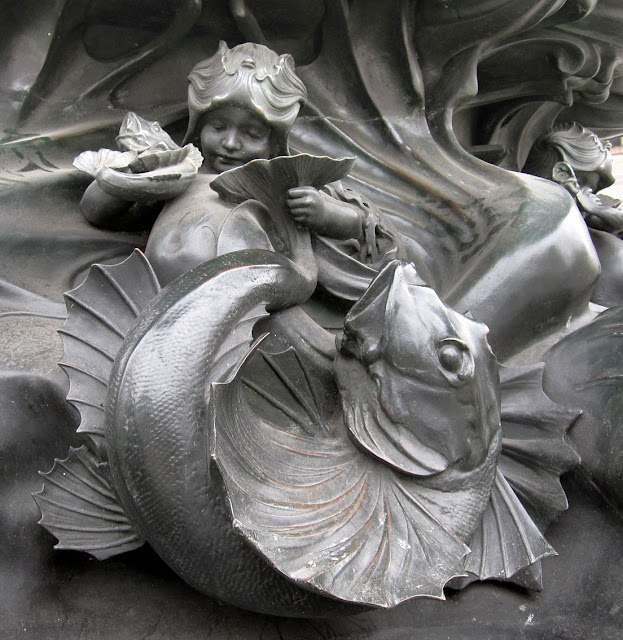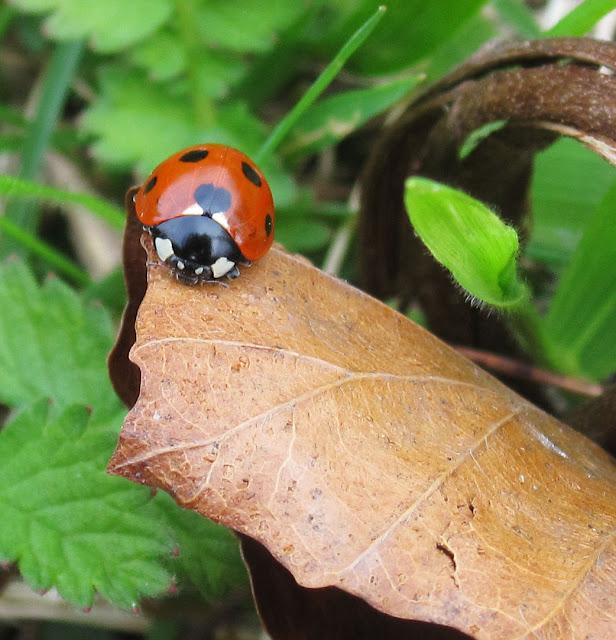 |
| Seven spot ladybird on Musk Orchid Bank, Cudham Valley |
Wednesday 30 March 2011
What I Saw #7
Tuesday 29 March 2011
Primrose Walk from Cudham
 |
| Walking down into Cudham Valley past Bottom Barn Farm |
We started in Cudham and walked down into the valley, onto Cudham Road, up Hang Grove Hill and off down to Musk Orchid Bank, from where some of us accepted a lift back.
Much of this is on the Cudham circular walk. The whole area is of interest to historians of science, as it is part of the area walked and recorded by Darwin when he lived at the nearby Down House. This area is once again (for the third time) being proposed to Unesco as a world heritage site. And there is some beautiful countryside.
 |
| A field full of cowslips in Cudham Valley |
These Bromley valleys were formed by runoff from melting ice at the end of the last ice age; there is no water in them now. The plateaus are clay with flint, and the valleys themselves are chalk.
Walking down the side of the valley, we passed several laid hedges. The slope itself was covered with scrubby trees until ten years ago, when they were cleared and a few sheep were introduced to prevent regrowth. This was an attempt to re-establish the chalk downland which became overgrown when rabbits died off on the introduction of myxomatosis. It has re-grown naturally since then with the local mix of plant species and is now well populated, though there is plenty of low thorn and bramble scrub up to about a foot high.
 |
| Cowslips in Cudham Valley |
Down at the bottom of the valley, a field belonging to Bottom Barn Farm is full of cowslips, introduced by re-seeding. We walked on to Cudham Road, a short section at the bottom of the valley between Downe Road and Hang Grove Hill. The coal-tax post there was erected to show a point at which tax could be levied on coal being brought into London.
At this point there is a privately owned field which was once a caravan site. It has regrown a lovely carpet of wild flowers; many primroses, lungworts, speedwells, and some less lovely ones like wild parsnips. There are some orchids here in season. There are also a few escapees from the old caravans, for example daffodils and goldenrod, which are less welcome.
 |
| Primroses on Primrose Bank, Cudham Valley |
The field is known as "Primrose Bank" and this name is well justified.
On the high sides of the valley are ancient woodlands, including Blackbush Shaw and Twenty Acre Shaw, which are managed by the Woodland Trust. We walked up Hang Grove Hill, through Hang Grove, and saw some interesting plants by the roadside; townhall clock, an indicator species for ancient woodlands, and toothwort, a plant with no chlorophyll that is parasitic on hazel roots.
Up the hill, we turned off to a site known as Musk Orchid Bank. This area is not accessible to the public; it is owned by Bromley council and managed by a tenant farmer. There are no musk orchids there now, as there were in Darwin's time. But it is covered with primroses, with some patches of cowslips. It's adjacent to Downe Bank, a nature reserve owned by the Kent WIldlife Trust.
There I also found the shell of a Roman snail, a very large edible snail species which I have never seen alive. Much bigger even than the large garden snails. I will be watching ..
Just as we left we saw a buzzard fly out of the woods for a few moments.
Random fact: Lesser celandine is sometimes called pilewort, and was used as a cure. One of the walkers said that the roots resemble piles, so this might just be sympathetic magic.
Here are a few more images:
 |
| The coal tax post in Cudham Valley |
 |
| Field Speedwell on Primrose Bank, Cudham Valley Later addition: I now think this might be germander speedwell. |
 |
| Townhall clock on the edge of ancient woodland in Cudham Valley |
 |
| Lungwort on Primrose Bank, Cudham Valley |
 |
| The group on Musk Orchid Bank, about to rest among primroses |
Monday 28 March 2011
Moths in Bromley Local Nature Reserves
 |
| Large and small moths presented by Paul Sokoloff |
This was very enjoyable. Paul is a confident and relaxed speaker who is clearly an expert.
Although he didn't give details, a web search shows that he is a Fellow of the Royal Entomological Society and writes for the Journal of Variation, currently a publication of the Amateur Entomologists' Society. And he takes excellent photos, using a 105mm macro lens with a ring flash.
My own photos in this article are poor quality, because they were taken in low light conditions. But they give the idea. I was pleased to see that moon moth because moonmoth is my user name in several places.
Those two very large moths are not native to Bromley, but apparently a moon moth was taken locally about 20 years ago .. probably bred by someone locally and released or escaped. All the others in the photo were native to, and taken in, the Bromley area.
 |
| A moth trap that can be plugged into the mains supply - not very portable |
Paul is not a compulsive moth killer. The usual procedure is to capture, examine, photograph and release them.
Random facts:
— There are just under 500 species of moths to be found in High Elms Country Park.
— The thing that burrows through horse-chestnut leaves so that they are all brown and dead by the end of the season is a moth, the Horse-Chestnut Leaf Miner; it was discovered in 1952 in Macedonia, and was scarce; it arrived in the UK 10 years ago and is now common.
— The Cinnabar moth caterpillar eats ragwort. The moth is nationally endangered, but its food is a notifiable weed, poisonous to horses, leading to something of a conflict of interests, though not usually embodied in a single person. (Actually there is no longer such a thing as a "notifiable weed," but ragwort is still poisonous and there is a code of practice on preventing its spread.)
— A moth called the Beautiful Snout eats bilberry, which surprisingly can be found on the heathland of Keston Common (which is a remarkable place).
All accompanied by beautiful photos taken by Paul S. himself. He did also show live specimens of four moth species; he would have brought more, but that's all that could be trapped this early in the year.
Labels:
High Elms,
insects,
invertebrates,
Keston Common,
mini-beasts,
moths,
plants
Sunday 27 March 2011
Saturday 26 March 2011
Thursday 24 March 2011
Thornet Wood and Sparrow Wood
 |
| The walk group outside Thornet Wood in Jubilee Country Park |
This park is heavily managed in an attempt to maximise biodiversity while maintaining it as a recreational area. The Friends group is very active and manages to find a good deal of useful sponsorship, and runs events and walks all through the year.
We started out through Thornet Wood, a small area of ancient woodland, meaning that it has been managed as woodland for at least 400 years. It has standard oaks, uncut and un-harvested, and coppiced hazel.
 |
| The Loosestrife Pond in Jubilee Country Park in March 2011 |
We passed by one of these which is known as the Loosestrife Pond. It has been partly cleared down to the clay in an attempt to deal with over-vegetation, while leaving half of it untouched to maintain the continuity of wildlife and plants. It is currently full of water, with tadpoles swimming around. In another pond, the recently created Ray's Pond, we saw some toads.
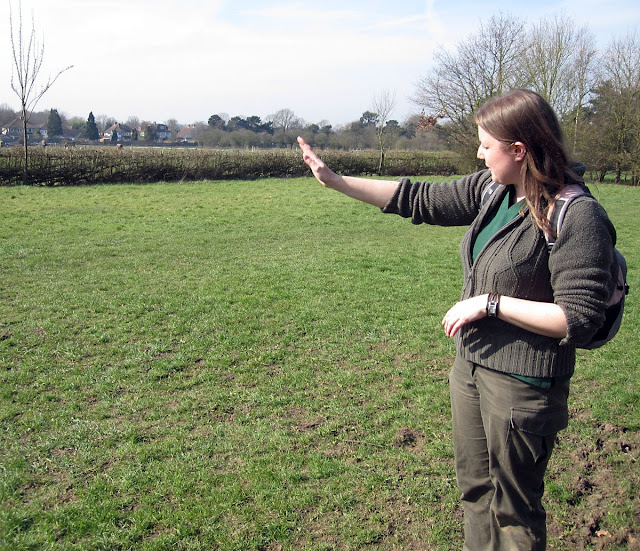 |
| Jenny Price gesturing towards a pleached hedge in Jubilee Country Park |
 |
| The stream through Sparrow Wood |
A stream runs through this wood, which eventually feeds into the Kyd Brook. It cuts through the Blackheath gravel which is so common in this area. At one point the party should have crossed the stream, but we could not scramble thorugh the wood to what might have been a good crossing, and the crossing we did find was certainly not achievable by most of the party. So some turned back to find and follow the London Loop route, while others jumped over at a narrow point and waited a little further on, where the woods opened up into Petts Wood Recreation Ground.
 |
| Frogspawn in the stream through Sparrow Wood in March 2011. In the shadow of a branch you can see more frogspawn below the surface. |
 |
| Wood violets in Thornet Wood, Jubilee Country Park, in March 2011 |
 |
| An old Elder in Jubilee Country Park covered with ivy and Xanthoria lichen. This yellow lichen stands out from a distance. |
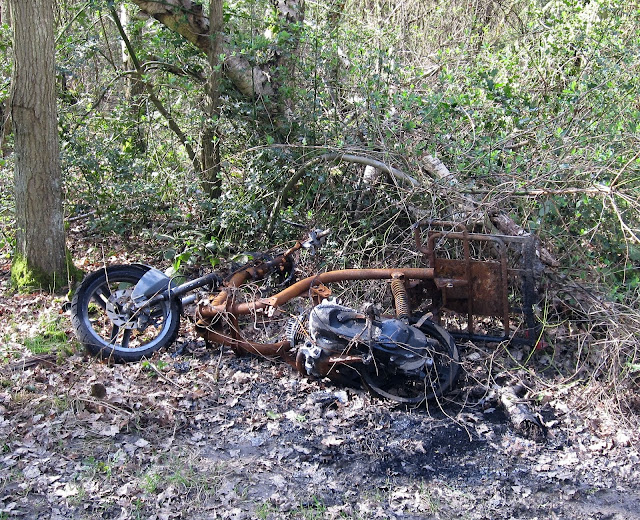 |
| A discarded bike in Sparrow Wood. The wood is mostly quite tidy. |
 |
| A split treetrunk in Sparrow Wood. If someone wanted a piece of treetrunk, this does not look like the easiest way to get it. |
Labels:
environment,
flowers,
Jubilee Country Park,
lichen,
plants,
trees,
walks
Wednesday 23 March 2011
Tuesday 22 March 2011
Monday 21 March 2011
A Gorgeous Gorgoneion
 |
| AE12 of Mallos in Cilicia, 4th century BCE |
The obverse or heads side, above left, shows a wreathed head. When I first got this coin it was not identified. I could see to the left of this head two letters in Greek, an old style of the letter Pi and an Upsilon, as shown on the left. I spent some while searching for a coin like this from a city with a name that started with these letters, and I didn't get very far.
Luckily for me, I was able to ask for help from the members of the Forum Classical Numismatics Discussion Board. There, I was pointed to the town of Mallos. The PY is actually the beginning of the name of the character depicted, not the town. It is the head of the river god Pyramos. By coincidence, I have recently written about another coin showing Pyramos here.
The reverse of the coin shows a round female face with curling locks looking out towards the observer. This is a gorgoneion, the face of a gorgon. There are many ancient coins with such a face, most of them much more contorted and horrific than this, often with the tongue sticking out. A gorgon's gaze was said to turn its object to stone, so this image was supposed to ward away evil influences.
The gorgoneion on this coin does not seem in the least frightening, and although not everyone likes this sort of thing, I think it has been made even more lovely by the range of warm colours that have developed during its patination.
Saturday 19 March 2011
Mosses on Keston Common
 |
| Mnium hornum in the old gravel pit on Keston Common |
A moss walk around the common, on Saturday 19th March, was led by a local botanist, Jan Hendey, accompanied by the BCS ranger, Judith John.
It was sunny and fresh, so we didn't freeze as we had on the recent Hayes Commmon lichen walk. Jan is a real expert and we walked around examining the beautiful mosses with hand lenses loaned by Judy.
Most of the mosses could be identified with just the lens, and you really do need the lens. As with all specialisms, if you are really familiar with them you can see many differences at a glance. Jan was naming most of the mosses on sight, and only confrming the identification with the lens; but even Jan was wrong once.
 |
| Botanist Jan Hendey handing out a moss specimen on Keston Common |
The moss species we looked at were common, which allowed for pieces to be passed out to everyone to examine.
We were on the southern part of the common, which is on Blackheath gravel and has acid soil. The rangers are gradually clearing trees and shrubs to allow it to revert to its previous heathland status; on the left we were on Ling heath (Calluna vulgaris) with Scots Pine and Silver Birch in the background. There is plenty of gorse just out of sight.
There are about 500 species of moss in Kent. We were shown 13: Mnium hornum, Dicranium scoparium, Hypnum cupressiforme, Rhytidiadelphus squarrosus, Brachythecium albicans, Campylopus flexuosus, Scleropodium purum, Pleurozium schreberi, Hypnum jutlandicum, Eurynchium praelongum (aka Kindbergia praelonga), Polytrichum commune, Sphagnum fallax and Fontinalis antipyretica. We learned something of how the names sometimes matched their appearance. If you see "common names" for mosses, they are nearly all recent inventions.
 |
| Sphagnum fallax in Keston bog |
The last named, Fontinalis antipyretica, grows in the water of the Keston Ponds and looks like a water weed. One of the group had read that it was used in Scandinavia to put out chimney fires, which if true would account for its name.
Other sightings included a scarce hoary cinquefoil on the heath, and a Brimstone butterfly, fluttering through the car park as we left.
 |
| Fontinalis antipyretica picked out of Keston Pond |
Friday 18 March 2011
Tuesday 15 March 2011
Monday 14 March 2011
Geology at High Elms
 |
| Paul Rainey crumbling a piece of Seaford Chalk |
Much of my current locality is chalk or gravel. How does this affect my current garden? Not at all, because the house was built on an old railway yard, and if I dig down a foot through the clay I find coke.
On Sunday there was a geology walk around High Elms Country Park and its immediate neighbourhood towards Farnborough, led by Paul Rainey of the Ravensbourne Geological Society. This area is almost all on chalk. You can see chalk very close to the surface; nearby, I have seen it turfed out of a badger's sett, and here it can be seen in road cuttings.
There is another way to see what is near the surface in woodlands in the south of England. All the woods have many trees that were toppled during the Great Storm of 1987, when winds of hurricane strength blew down an estimated 15 million trees. I got that number from Wikipedia, but I remember that night well. When those trees were pushed over, their root balls were tilted up and they brought with them all the attached soil. That soil is still mostly there and gives you a very good idea of what's under the topsoil, without having to dig.
 |
| Flint Lodge, the gatehouse to High Elms, showing flint in the walls |
Chalk, of course, is full of flints. The Blackheath gravel layer of the nearby Hayes, Keston and West Wickham commons consists of small black flint pebbles, created where a sea has broken up larger flints and rolled them around. There were many such pebbles on the surface as we walked, which must have come downhill from elsewhere, as there is no gravel layer here.
Flints were a valuable resource in the stone age, and in more recent times they were used to surface walls, for protection or decoration. The area is full of houses and churches that demonstrate this. The second photo shows Flint Lodge, the gatehouse of the High Elms estate, which demonstrates this in name and in fact. The white border around the broken edges shows that these flints were freshly dig for this use. That border is usually weathered off on flints taken from the surface.
 |
| A chalk pit in High Elms Country Park |
The various soils and rocks in this area have in the past been used as resources by the locals. The playing fields at Farnborough were once a sand pit. The gravel at Keston Common was a local resource. And here in High Elms Country Park is a chalk pit.
It goes down about 30 feet and branches out into three short excavations. This is where chalk was excavated to put on the fields, though just why the fields weren't already chalky enough I do not know. Chalk was taken from deep down because that nearer the surface was only good for paths and roads, not for the fields. This pit is now a home to bats; I wasn't able to find out what type.
(Added later: I have since heard from Ishpi Blatchey, a local bat expert, who wrote: "The ... dene hole .. is a bat hibernation site - not used in the summer as it is too cold for maternity roosts. Brown long eared, Daubenton's, and Natterer's bats are regularly seen there in winter by licensed bat workers who monitor the site for the National Bat Monitoring Programme." Here is a note of one of Ishpi's bat walks.)
As you can see, it rained during this walk ...
Here are some random images.
 |
| Cut ivy stems on a felled treetrunk near High Elms |
 |
| Last Autumn's fallen leaves with signs of tar spot fungus |
 |
| Weathered gate ball at The Clock House, High Elms |
Friday 11 March 2011
Part of The Beck Corridor
 |
| The Beckenham Village sign on Beckenham Green |
The Beck Corridor follows the route of the river Beck, which probably got its name from the village, rather than the other way around as one might think. When the railway arrived in 1857, the little village of Beckenham began to grow, and is now a small town, a suburb of London. But it likes being a distinct community, and this is the village sign at Beckenham Green, just by the church, where the walk started. Beckenham Junction station is visible over the crossroads.
 |
| An old signpost in Beckenham |
We looked around the churchyard, which was full of old graves and their stones and enclosures. Everywhere were plants and flowers, some cultivated and some wild, growing over and around the stones and memorials. Primroses and celandines were in flower. Some might say this looks unkempt, but it is good for biodiversity. And the churchyard was not neglected; potentially damaging baby trees were cut back.
We left through the 13th century lich gate (much restored) and walked through the town, past the old signpost in the second photo, to Kelsey Park.
This is a wonderful park to find in a suburb. It contains two lakes formed by damming the Beck, which are full of bird life in daytime and bat life at night. I have seen Daubenton's Bats as well as common and soprano pipistrelles. (But not on this walk. At night, in summer.)
The photo below was taken at the Beckenham end of the park, where the gate is dedicated to Tom Edward Thornton, 1857-1933, "former editor and proprietor of The Beckenham Journal, through whose efforts this park was acquired in 1913 for the enjoyment of the public." There is a lot of local history not readily available on line.
 |
| Ewa Prokop and a walker by the east gate of Kelsey Park, Beckenham |
There is an ice-house at the far end of the park which originally belonged to the Kelsey Manor Estate. There are several ice-houses and ice-wells scattered around the borough of Bromley, probably one for each estate. This one would have been supplied from the lake.
Over the road from the park is the entrance to the Harvington Estate, another woodland through which the Beck runs. There is still a line of Scots Pines which probably lined the original driveway. The big old cedar in the next photo would have been close to the house.
You can just about make out at the base of the cedar how the hollows have been filled with concrete and wire mesh. This method of caring for trees is not followed these days. The trees are strong enough without it, and decay fungi are just as likely to be trapped behind the concrete as they are to get into the tree without it.
 |
| Ewa Prokop and a walker by a big cedar in the Harvington Estate |
The trouble with photography on overcast winter days under trees is that there isn't enough light for real sharpness with my little digital camera. I don't have any really standout shots from this walk. Photos like this one of Ewa are a little bit fuzzy.
Past the estate, we walked through Harvington Park and then along some roads to High Broom Wood. This is a stretch of ancient woodland along the Beck. It is surrounded by houses and estates, so does not get the kind treatment it deserves. There are some new tree sculptures in the park, and one has already been vandalised; a dragonfly's wings have been broken off. But the park has a "friends" group, and is clearly managed.
High Broom Wood is a wet woodland, or carr, and has many alders. Their purple leaf buds and purple catkins were quite colourful close up. Those shown below seem to be unopened, and you can see the rounder female catkins from last year in the background. There are some willows and also a great deal of pendulous sedge, which can be a real pest in a damp garden as they reproduce and grow at a great rate. (Personal experience there.)
 |
| Male alder catkins on a fallen branch in High Broom Wood |
We also saw celandines, wood anemone and wood sorrel, all in flower, and lots of bluebells growing up strongly.
Part way through High Broom Wood, the walk ended, and we split up to make our various ways home.
Monday 7 March 2011
Blackthorn in Hayes
 |
| Blackthorn bush in Hayes |
The blackthorn makes the first big show in the wild hedgerows in the south of England. Of course, there are cultivated garden shrubs that beat it into blossom or equal it, but they don't grow in the wild.
Someone has tried to tame this example. It grows in a hedgerow by a roadside in Hayes, and at people height it is kept pruned because it would otherwise invade the footpath. It doesn't have "thorn" in its name for nothing. In that respect it is rather like the hawthorn, another hedgerow shrub. Also like a hawthorn, it can grow quite large; more like a small tree than a shrub. Up above, all attempts at taming have failed.
The blackthorn's mass of white flowers is a very cheering sight at the beginning of March. This one is only just coming into bloom and has a mixture of flowers and buds.
 |
| Blackthorn flowers close up. Fresh, white, essence of spring. |
The fruit of this bush is the sloe, small and dark, normally called a berry but technically a drupe. Sloe gin is made by soaking the berries in normal gin.
Subscribe to:
Posts (Atom)
